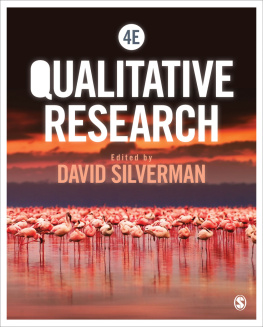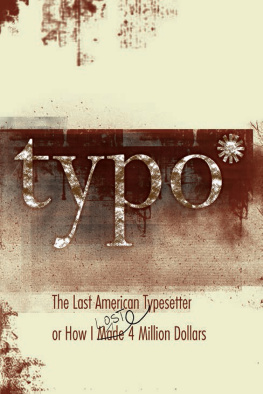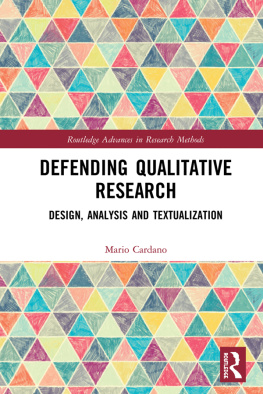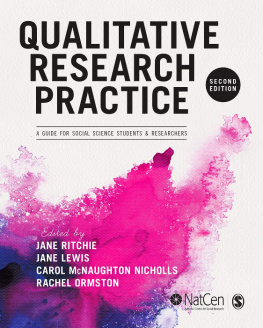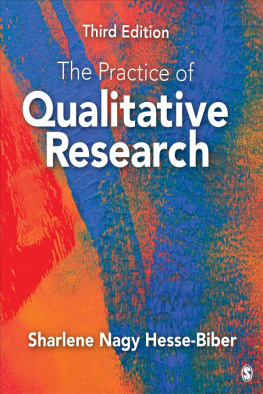A VERY SHORT, FAIRLY INTERESTING AND REASONABLY CHEAP BOOK ABOUT
QUALITATIVE RESEARCH
A VERY SHORT, FAIRLY INTERESTING AND REASONABLY CHEAP BOOK ABOUT
QUALITATIVE RESEARCH
SECOND EDITION
DAVID SILVERMAN


SAGE Publications Ltd
1 Olivers Yard
55 City Road
London EC1Y 1SP
SAGE Publications Inc.
2455 Teller Road
Thousand Oaks, California 91320
SAGE Publications India Pvt Ltd
B 1/I 1 Mohan Cooperative Industrial Area
Mathura Road
New Delhi 110 044
SAGE Publications Asia-Pacific Pte Ltd
3 Church Street
#10-04 Samsung Hub
Singapore 049483
Editor: Katie Metzler
Assistant editor: Anna Horvai
Production editor: Ian Antcliff
Copyeditor: Solveig Gardner Servian
Proofreader: Jennifer
Hinchliffe Marketing manager: Ben Griffin-Sherwood
Cover design: Wendy Scott
Typeset by: C&M Digitals (P) Ltd, Chennai, India
Printed and bound by: CPI Group (UK) Ltd,
Croydon, CR0 4YY

David Silverman 2013
Published 2007, reprinted 2007, 2008 (twice), 2009, 2010 and 2011
Apart from any fair dealing for the purposes of research or private study, or criticism or review, as permitted under the Copyright, Designs and Patents Act, 1988, this publication may be reproduced, stored or transmitted in any form, or by any means, only with the prior permission in writing of the publishers, or in the case of reprographic reproduction, in accordance with the terms of licences issued by the Copyright Licensing Agency. Enquiries concerning reproduction outside those terms should be sent to the publishers.
Library of Congress Control Number: 2012931571
British Library Cataloguing in Publication data
A catalogue record for this book is available from the British Library
ISBN 978-1-4462-5217-8
ISBN 978-1-4462-5218-5 (P)
Dedicated to my friends who are residents on the first and second floors of the Lady Sarah Cohen Home, London: Helen, Harry, Rita, Yvonne, Sam, Rachel, Rosalind, Hannah, Leon, Frank and many others. Thank you for what you have brought into my life.
Contents
Acknowledgments
Like many publishing ventures this book originated at a lunch with my then Editor. Although it was a very fine lunch, I was not initially receptive to Patrick Brindles suggestion that I write a new book. Since my retirement from full-time teaching, I have concentrated upon the less demanding task of updating editions of my various textbooks. It was only later that I realised that the kind of provocative book Patrick wanted could be based on the lectures I had given over the past few years for the Qualitative Research Network of the European Sociological Association (ESA). Following a few emails between us, the present book is the product.
As Patrick requested, it is unashamedly based upon the formula used by Chris Grey in his book A Very Short, Fairly Interesting and Reasonably Cheap Book about Studying Organisations (Sage, 2005). Im afraid I have stolen most of Chriss title as well as his idea to write a provocative introduction to my field in a non-textbooky kind of way. I hope he will forgive me.
Patrick has been a marvellous editor and critic. For this Second Edition, I am equally grateful for the advice and support of my new editor, Katie Metzler.
Many other people have been generous about reading and commenting on earlier drafts. I wish to thank Jay Gubrium, Alexa Hepburn, John Heritage, Celia Kitzinger, Ross Koppel, Doug Maynard, Anne Murcott, Jonathan Potter, Anne Ryen, Clive Seale and Gary Wickham. You have all inspired me, as have my friends and colleagues at the ESA Network.
At a personal level, I want to thank Sara Cordell for keeping my back in working order and my friends at The Nursery End NW8 (Leslie, Sol and John) for making my summers something to which I look forward. My children, Danielle and Andrew, have helped in ways they may not realise by challenging, in a loving spirit, the way I look at the world. Finally, I must thank my wife Gillian for her love and support.
Introduction to the
Second Edition
This volume is intended as a lively, argumentative and personal pre-textbook a taster for the issues involved in using qualitative methods. The most noticeable addition is a Glossary of Received Ideas. I have taken the name from the marvellous Dictionary of Received Ideas which appears at the end of Gustave Flauberts nineteenth-century novel Bouvard and Pecuchet (2005). Like Flaubert, my aim is to debunk the accepted understandings of our time.
Most textbook glossaries seek to define terms which are central to their specific area. By contrast, my glossary lists terms which, although part of the conventional wisdom of qualitative research, to my mind, either mislead or misdirect us about what such research can offer.
The first edition of this book used many illustrative examples from art, literature and the theatre. However, in the second decade of the twenty-first century, I recognise that the Internet has transformed how we communicate. Consequently, this new edition adds considerable illustrative material from social media and other websites. I also make it clearer that this book will appeal most to those who primarily think of qualitative research as having an ethnographic character and use more examples from research studies to explain how we can pay attention to the sequential organisation of qualitative data.
Preface: Making a Space
for this Book
What do you imagine goes through the mind of authors as they write a book? Do you picture lonely geniuses or misguided bores who feel compelled to get into print knowing that their words will be misinterpreted or, still worse, ignored? Or do you think of the solid artisan who ploughs through masses of material in order to produce a work that will be acceptable to the maximum number of readers?
For the past decade or so, I have attempted to be such an artisan. The textbooks and edited readings I have produced (Silverman, 2010, 2011 and 2012) have aimed to be comprehensive and balanced. In pursuit of this aim, they have also been rather long. By contrast, this book is short and intentionally opinionated and partial.
We live in an age when qualitative research is often identified with open-ended interviews which aim to peer into peoples inner experiences. By contrast, taking a constructionist perspective, this book favours using naturally-occurring data to study behaviour, positioning itself within certain kinds of ethnography and discourse and conversation analysis (CA).
This volume also lacks many traditional textbook features such as bullet-point lists, exercises and recommended readings. Even its glossary is meant to be provocative rather than a revision list of agreed definitions. So why on earth should you consider buying it?
If you want to be spoonfed or to find a quick read which you will dip into in order to scrape a pass on a research methods course, this is not the book for you. By contrast, my aim is to stimulate you by making you reconsider some assumptions that textbooks trade off.
This book comes with no claims to get you through a course. At best, an encounter with less conventional reading such as this may earn you some favour with teachers who are bored by pre-digested, textbook answers.
Next page

